Warships range from old battleships to modern frigates and well-armed destroyers; however, all are capable of bringing heavy firepower to bear against the BETA. From the impressive fusillades of the Yamato-class battleships to the advanced missile systems of the Ticonderoga-class Cruiser , warships are intended to reduce the area they target into a smoking plain, either to clear the area for troops to land and prepare to face the next relentless wave of BETA without interruption, or to cover a desperate retreat by beleaguered allies.
Japanese Warships[]
Tsushima-class Gunboat[]
Ships of the line: Others
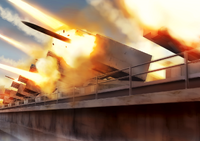
(MLA) A Tsushima-class initiating support fire with its numerous MRLS emplacements.
- A large supertanker ship modified to carry numerous Multiple Rocket Launch Systems, the Tsushima-class gunboat is closely related to the Ōsumi-class TSF Landing Ship in that both use the same modified supertanker design as their basis.[1]
- The Tsushima-class was present during Operation 21st , providing surface-based rocket fire in supporting allied forces in their shore landing on Sadogashima.
Yamagumo-class Destroyer[]
Ships of the line: Others
- A light destroyer, the Yamagumo-class is a relatively new addition to the Imperial Navy. One such vessel was part of the interception fleet at the Invasion of Niigata in 2001.
Mogami-class Cruiser[]
Ships of the line: Mogami, Mikuma

(MLA) Mogami keeping pace with other ships.
- The Mogami-class cruisers, displacing a little under 30 000 tons, are high-speed warships with three 30.5cm three-barreled gun turrets as their main armament.[2]
- With a structural arrangement and similarity to heavier battleships, excellent command and control capabilities, as well as having cruising capabilities and high speed, the cruisers were also capable of serving in a flagship role;[2] Mogami acted as both the flagship of the IJN forces present, as well as for the IJA's Whiskey Unit, during Operation 21st.[2]
- Her sister ship, Mikuma, is noted for her slight physical difference from Mogami, having been used as a prototype for anti-laser construction while work was being carried out on the Kii-class battleships.[2]
Yamato-class Battleship []
Ships of the line: Yamato (大和), Musashi (武蔵), Shinano (信濃), Mino (美濃)
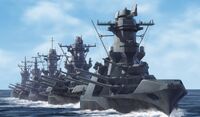
(MLA) A fleet of Yamato-class battleships during Operation 21st.
- The Yamato(大和)-class battleship, the famed battleship class of Imperial Japan during World War II, these four warships, initially planned as battleships, from the construction of Mino and Kaga onwards, first had some of their heavy armor removed to match speed with carrier groups as combat escorts, and were later refitted with more anti-aircraft weapons due to the increasing threat of naval aircraft.[3] Spared from the decommissioning of numerous IJN capital ships when the Japanese were defeated in 1944, the Yamato-class continued to serve the Japanese navy during the Cold War period. As naval technology improved, the warships were then scheduled for decommissioning.[3]
- In the 1970s, the BETA advance resulted in the IJN bringing the Yamato-class warships back into active service. The current Yamato-class ships have gone through extensive refitting; external appearance, gun systems, and armor have been overhauled, improved, and replaced, with firing guidance systems utilizing satellite data-link, close-in anti-laser defences launched by VLS, and an anti-laser coating on its hull.[3]
- The Yamato-class would participate in numerous battles when the BETA reached Japan, and were present when the island of Sadogashima was lost to the BETA advance.
Their next notable operation would be at the Operation 21st, providing valuable artillery support to the TSF forces on the island.
The Yamato and Shinano were engaged in combat operations during the 8th Border War, but did not engage any enemies.
Yamato Kai-class Battleship[]
Ships of the line: Izumo (出雲), Kaga (加賀)
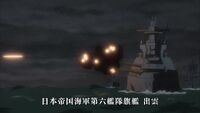
(TE An.) The Izumo at Tsushima Strait, firing a full broadside barrage at BETA island-hopping from the Korean Peninsula.
- A variant design of the Yamato-class battleship design dating back to World War II, the Yamato Kai(改大和)-class was originally planned as a hull conversion of the fifth and sixth Yamato-class ships into large open-deck aircraft carriers to replace those that had been lost in combat against US forces during World War II.[4] However, when the cost of such a conversion was deemed to be costlier than a new carrier construction, the design of the ships were instead modified into, and built as, aviation battleships, with their third gun turret, located towards the stern of the ship, removed to make space for a hangar and a flight deck.[4]
- While the usefulness of the Yamato Kai-class was called into question during its construction, the ships, which survived the decommissioning of much of the IJN's surviving capital ships following the Japanese surrender in World War II, proved themselves as able helicopter carriers in the time period in-between the end of World War II and the BETA War, while retaining their naval gunfire support roles, and were regarded as highly useful vessels.[4] When the BETA War came about, the Yamato Kai-class ships received upgrades similar to those given to the Yamato-class, including the removal of angular surfaces from the ships' overall profile, and the application of anti-laser hull coating, the addition of a large-scale VLS.[4]
- The Yamato Kai-class warships, together with the Yamato-class battleships and the Kii-class super battleships, would become a portion of the IJN's main strength.[4] Notable deployments include the Izumo, which was under the command of Admiral Yammaguchi and used its powerful guns to provide support fire during the Defence of Kyoto in 1998, and later during the Defence of Yokohama Base in 2001. Kaga was part of the second naval battlegroup during Operation 21st.
Kii-class Battleship[]
Ships of the line: Kii (紀伊), Owari (尾張)
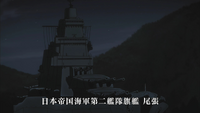
(TE An.) Owari, stationed in Lake Biwa during the Defence of Kyoto.

(TE An.) The Owari alongside a TSF carrier stationed in Lake Biwa.
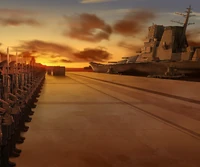
(MLA)A Kii-class can be seen in the background.
- Developed as a successor to the Yamato-class battleships, the Kii-class battleships were originally intended to match the US Navy's Montana-class battleships in all aspects, with construction beginning in 1941.[5] Work on the Kii-class stalled at the end of World War II, with 60% of the first ship completed, but was eventually restarted in short order by both the Imperial Japanese Navy and their new allies, the USA, as a defence against the emerging Soviet Union and her communist allies.[5] Supported by the US Navy, the Kii-class was then envisioned to match the Soviet Navy's Sovetsky Soyuz-class battleships, and construction was then completed with that train of thought.[5] The first ship, Kii, was completed in 1949; the second, Owari, was completed in 1951. Plans for the construction of two more ships, Kai (甲斐), and Suruga (駿河), were cancelled, leaving Kii and Owari as the only two examples of their kind.[5]
- The Kii-class' original main armament were three double-barreled 50.8cm gun turrets; upgrades to the design prior to the end of WWII, made to surpass the specifications of the Montana-class, resulted in the final fitting of four triple-barreled 50.8cm gun turrets as its main armament. The ship type, in total, displaced 110,000 tons, making it the heaviest surface combatant ship in history.[5]
- Both Kii and Owari served in rotations as the flagship of the IJN Combined Fleet, receiving numerous anti-air and anti-submarine upgrades before both ships were placed in reserve duty, and moored at Kure.[5] The beginning of the BETA invasion of Earth in 1974, however, saw both ships returned to active duty as part of the IJN's main fleet. After a deployment to the Indian Ocean in 1992, both Kii and Owari returned to Japan for upgrading; over the span of a year and a half, both were refitted with satellite data-link capabilities and guided missile systems, as well as anti-laser hull coatings, structural reinforcements, and armor. In 1995, both ships returned to active duty.[5]
- Both Kii and Owari participated in numerous operations in the defence of Japan during the 1998 BETA Invasion of Japan; Owari acted as the flagship of the Second Fleet, which at that time was stationed at Lake Biwa to provide fire support. Both ships also served during the start of Operation Lucifer, the Defence of Yokohama Base, as well as numerous other key operations.[5]
American Warships[]
Oliver Hazard Perry-class Frigate []
Ships of the line: USS Vandegrift, Others
- A ship intended for multiple battlefield roles, the Oliver Hazard Perry-class is a frigate designed to support both naval and landing operations. One such ship, the Vandegrift, was sunk during the massive gravitational anomaly that swept the John F. Kennedy and its escort vessels off-course.
Ticonderoga-class Missile Cruiser[]
Ships of the line: Gettysburg, Others
- The Ticonderoga-class missile cruiser is a naval warship of the US Navy. A marked departure from the typical battleship, its main armaments are missiles launched by VLS, allowing it to fire powerful guided cluster munitions against BETA hordes.
Zumwalt-class destroyer[]
Ships of the line: King, Others
- A relatively modern warship, the Zumwalt-class is a high-speed assault destroyer class of the US Navy.
Iowa-class Battleship[]
Ships of the line: Iowa, New Jersey, Missouri, Wisconsin, Illinois, Kentucky
- The Iowa-class battleships are a class of high-speed battleships built during World War II. A new model of warship for its time, their construction was made possible by Japan's withdrawal from the London Naval Treaty, and the treaty's subsequent collapse.[6] With a standard displacement of 45 000 tons, the Iowa-class had a complement of 40.6cm three-barreled main turrets (for a total of nine cannons). While its armament was smaller than that of the comparable IJN Yamato-class battleships, the Iowa-class' main guns usage of heavier ordnance gave them increased firepower.[6] The Iowa-class' high speed also allowed the ships to serve as carrier group escorts, and together with the Montana-class battleships, both US Navy battleships types clashed with the IJN's Yamato-class and Nagato-class battleships several times over the course of World War II. The Iowa-class battleships also took on a myriad of duties during this period, from direct battle to shore bombardment.[6]
- After World War II, the USA's focus on the development of space-borne assets and the establishment of the Space Corps meant that constant maintenance of high-cost assets were no longer a possibility.[6] One of these assets was the Iowa-class battleships; the costs were shared with the Empire of Japan as part of the US-Japan Mutual Security Treaty, and the ships were placed into the reserve fleet.[6]
- When the BETA War broke out in 1974, the Iowa-class battleships were brought out of reserve and back into active service. Upgrades to the ships included cruise missile launch capabilities, anti-BETA defences and optimizations, and other upgrades.[6] From then on, the Iowa-class served almost exclusively as a core component of the UN Fleet, as stipulated under the UN Charter, Section 43. The ships participated in operation theaters worldwide, from the Mediterranean Sea, to the Indian Ocean, and the Sea of Japan.[6] In particular, Iowa, New Jersey, Missouri, Illinois, and Kentucky are a part of the United Nations Pacific Fleet, based in Sasebo Base, in Japan.[7]
Montana-class Battleship[]
Ships of the line: Montana, Ohio, Maine, New Hampshire, Louisiana
- A new class of battleships intended as a replacement for the Iowa-class, the Montana-class was designed as part of a new set of tactics to form the core of a strike group alongside American carriers. One such strike group was centered around the Mediterranean area, intended for offshore support of European war efforts against the BETA.
Soviet Warships[]
Slava-class Cruiser[]
Ships of the line: Others

(TE VN) A Slava-class cruiser.
- A warship class of the Soviet Navy. Its main armament are sixteen launcher tubes, allowing for a withering hail of rocket artillery.
Sovetsky Soyuz-class Battleship []
Ships of the line: Sovetsky Soyuz, Sovetskaya Ukraina, Sovetskaya Rossiya, Sovetskaya Belorussiya
- A World War II-era battleship design, the Sovetsky Soyuz-class had a displacement of 61 510 tons and carried three three-barreled 40.6cm gun turrets as their main armament.[8] Construction on the ships, which had began in 1938, had been halted due to the Russon-German War during World War II, due to the need for the urgent expansion of the Soviet Army against the invading German forces.[8] During this period, the partially-completed Sovetskaya Ukraina was seized by the Germans, and eventually destroyed, leaving the Soviet Union with three partially-completed ships of this class.[8]
- After the end of World War II, construction on the ships were restarted, and completed, some time before the Korean War, in order to counter the strength of the US Navy/Imperial Japanese Navy.[8] However, lack of relevant knowledge on the building of large-scale warships, especially in the construction of large-bore naval cannons, resulted in a delayed construction schedule, and issues with the ships continued after their commissioning.[8]
- After the BETA War began on Earth, the ships, which were unable to participate due to the inland nature of the conflict, were considered for decommissioning numerous times.[8] However, when the BETA advance reached far enough to threaten locations closer to the continental shorelines of Eurasia, the Sovetsky Soyuz-class ships were finally able to display their firepower in various hectic battles, saving the lives of numerous military personnel and civilians.[8] With the need for support firepower from these ships recognized by the Soviet Armed Forces, the Sovetsky Soyuz-class battleships were assigned to the defence of the Sea of Okhotsk and Soviet defence in the Far East.[8]
- Sovetskaya Rossiya is currently deployed to the Kamchatka Peninsula to provide firepower support.
Udaloy II-class Destroyer[]
Ships of the line: Others
- A warship class of the Soviet Navy.
Australian Warships[]
Hobart-class Destroyer[]
Ships of the line: Sydney, Others
- A modern destroyer of the Royal Australian Navy, the Hobart-class is capable of dishing out incredible amounts of firepower with its VLS and naval cannon. One ship, the Sydney, was a UN liaison accompanying the USS John F. Kennedy on its mission against the Cheorwon Hive, and later served as a fleet member of the JFK Naval Garrison Base's ship complement. Despite its immobility caused by a critical shortage of fuel, the ship's powerful armament served the defenders JFK Base well.
European Warships[]
[]
Lion-class Battleship[]
Ships of the Line: Lion, Temeraire, Conqueror, Thunderer, others
- A World War II Battleship of the Royal Navy, after the end of World War II the class of battleships was scheduled to be scraped or decommissioned. The Battleships of the Lion-class are armed with three 40.6cm cannons in triple turrets with each turret fitted with triple barrels of these guns. However the Soviet Union was considered a major threat to British interests, but the BETA War broke out in 1974 and the battleships were continuously upgraded to protect itself with anti-laser armor. In 1983 one of the Lion-class ships participated in Operation Neptune, along with a Montana- and Iowa-class Battleships.
EESA/Warsaw Pact Warships[]
Volksmarine[]
H-class Battleship[]
Ships of the Line: Karl Marx, Fuhlendorf
- Warships of the East German Navy that participated in Operation Neptune. Its unknown how long the main guns of these ships are and what class they belong to. Karl Marx is the Flagship of the GDR Navy, the other Fuhlendorf was sunk by Laser class BETA during the operation.
Trivia[]
- The real-world history of the Yamato-class battleship line was much less lasting than their Muv-Luv counterparts. Yamato and Musashi were sunk during WWII. Shinano was modified into a carrier, and two other warships were planned and later scrapped and abandoned; Mino never existed.
- The Tsushima-class gunboat is a fictional ship class; no such vessel type existed within the real-world historical Imperial Navy, or with the current Japanese Maritime Self-Defence Forces.
- The Mogami-class cruiser in Muv-Luv is referred to being the third ship to hold that name. However, the ship in Operation 21st is clearly that of a World War II-era Mogami-class cruiser, the second known ship/ship type to use the name of Mogami; in reality the third user of the Mogami name was an Isuzu-class destroyer escort.
- The Yamato Kai-class is a fictional battleship class; its ship type, however, was that of an aviation battleship/carrier battleship, of which several examples, like those of the Ise-class battleships, exist. Izumo was actually a cruiser, while Kaga existed as an aircraft carrier. But in the modern real world, Izumo and Kaga become Izumo-class multi-purpose destroyer or a helicoper carrier and in 2021, its have been converted into Aircraft Carrier
- The immense firepower and all-rounded capabilities of the Kii-class appears to be a reference to the unbuilt A-150 class of warships in the real world; both the A-150 design and the Kii were originally intended to be equipped with dual-barreled gun turrets (51cm for the A-150, 50.6cm for the fictional Kii), both were designs ready for construction in 1941, and both were intended to counter the Montana-class battleship design.
- Of all four Sovetsky Soyuz-class battleships in the Muv-Luv universe, none of which were ever completed in the real world, only Sovetskaya Ukraina correctly mirrors her historical counterpart; the ship had been seized by German forces and her partially-completed hull stripped for fortifications, with damage to the hull further exacerbated beyond repair when the Germans retreated.
- The H-Class Battleship in the real world is never exist and only his purpose is exist, Fuhlendorf and Karl Marx is could be and model name for H-Class Battleship after German has lost WWII
- Lion-Class in real world is never existed, but the blueprint is exist (maybe)
- The real-world Royal Australian Navy's Hobart-class destroyers are not slated to enter service until 2015.
Gallery[]
References[]
- ↑ Integral Works, pg. 183, 上陸支援艦, 大隅級戦術機揚陸艦.
- ↑ 2.0 2.1 2.2 2.3 Integral Works, pg. 181, その他の水上艦艇, 最上級大型巡洋艦.
- ↑ 3.0 3.1 3.2 Integral Works, pg. 180, 戦艦, 大和級.
- ↑ 4.0 4.1 4.2 4.3 4.4 Integral Works, pg. 180, 戦艦, 改大和級.
- ↑ 5.0 5.1 5.2 5.3 5.4 5.5 5.6 5.7 Integral Works, pg. 180, 戦艦, 紀伊級.
- ↑ 6.0 6.1 6.2 6.3 6.4 6.5 6.6 Integral Works, pg. 181, 戦艦, アイオワ級.
- ↑ Integral Works, pg. 226, 国連総合海軍.
- ↑ 8.0 8.1 8.2 8.3 8.4 8.5 8.6 8.7 Integral Works, pg. 181, 戦艦, ソビエツキー・ソユーズ級.
- ↑ http://russian-ships.info/pics/11551.gif






![Udaloy-II class.png (1.92 MB) (TE-VN) An Udaloy II-class[9] of the Soviet Navy.](https://static.wikia.nocookie.net/muvluv/images/d/db/Udaloy-II_class.png/revision/latest/scale-to-width-down/120?cb=20130525022234)



